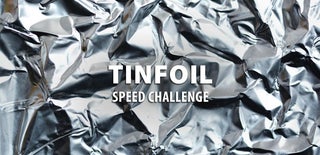Introduction: Foil + Hydrochloric Acid = Awesome Chemistry Experiment
WARNING: This experiment involves hazardous materials and fire. DANGER: Possibility of injury!
Please don't try this at home. I recommend suggesting the activity to a chemistry teacher or someone who will have the proper safety tools at their disposal. I am not responsible for any injury you may sustain during the recreation of this experiment. You assume all risk and liability. The chemical reaction is exothermic and generates a significant amount of heat along with an aqueous aluminum chloride solution.
The reaction of Aluminum and HCl: 2Al + 6HCl ----> 2AlCl3 + 3H2
Now let's have some fun!
Supplies
Safety Goggles
Aluminum Foil (aka Tin Foil)
250 mL Flask
9 inch balloon
Scissors
Ruler
Binder Clip
Matches (now you know this is going to be awesome!)
You may want to have a fire extinguisher nearby just in case.
Step 1: Foil + Hydrochloric Acid Chemistry Experiment
This experiment is perfect for the mad scientists out there because of the intense reaction. It is also perfect for science teachers because the materials are relatively cheap and easy to come by (always a plus on an educators' budget), and the reaction that takes place is quite simple for students to understand.
Educational objectives can be modified for different ages and ability levels. NOT recommended for students younger than 8th grade.
Student will demonstrate ability to:
- create a replacement reaction
- describe what happens during a chemical change and four possible clues that it has taken place
- apply the law of conservation of mass to chemical reactions
- relate pure chemistry to applied chemistry
- describe the relationships among the temperature, pressure and volume of a gas
- write a word equation
- write a balanced chemical equation
- Extension: identify areas affected by chemistry research
Step 2: Procedure
- Read all steps of the procedure before performing the experiment.
- Place safety goggles on your face.
- Add 100 mL of Hydrochloric Acid to the flask
- Measure and cut a 6 inch by 6 inch square of aluminum foil. (If you use more than 6x6, you risk the balloon bursting and spraying droplets of very hot aqueous aluminum chloride on everything within a 10 foot radius :(
- Get ready for your adrenaline to start pumping.
- Before proceeding with the experiment, read the chemical formula below to help understand the chemistry behind the reaction.The reaction of Aluminum and HCl: 2Al + 6HCl --> 2AlCl3 + 3H2
- Ball up your foil
- Drop the foil into the flask. You will have approximately 30 seconds before the reaction gets going.
- Quickly stretch the balloon over the mouth of the flask. Don't waste a single second when fixing the balloon over the mouth of the flask. The balloon must be placed over the mouth of the flask immediately after the aluminum and HCl are combined.
- Observe the reaction from a safe distance. When the reaction really gets going, bubbles will form. These bubbles will climb higher and higher inside the flask. It is not uncommon for some of the bubbles to enter into the balloon. If you use more than a 6x6 sheet of foil, chances are very good the experiment will end with less than desirable results. These bubbles are very hot and the flask will become too hot to touch.
- When the bubbles settle down and the reaction is finished, twist the balloon 3 or 4 times to trap the hydrogen gas inside.
- Pinch the area you twisted and remove the mouth of the balloon from the flask.
- Tie off the end of the balloon.
Step 3: Experiment Part 2: Flammability of Hydrogen Gas
Now we want to double check to make sure we captured hydrogen. Here's how I tested it. You can use your brains to figure out the best way with what you've got.
I tied string to a beam running along the ceiling of my classroom. I had the string hang down near the middle of the room where I made sure there was no danger of anything catching fire.
Next, I tied a large binder clip to the end of the string (more mass).
I attached the hydrogen-filled balloon to the binder clip.
I used duct tape to combine two meter sticks. A small binder clip was attached to the end of one of the meter sticks with a small strip of duct tape. Two matches were placed into the clamp of the small binder clip. A third match was used to ignite the matches in the grasp of the small binder clip.
Hold the matches near the bottom of the balloon, but not directly at the bottom. I have found that water vapor (or some other liquid) ends up in the balloon with the heat of the reaction. If you hold the match at the lowest point of the balloon, there is a good chance some of the liquid has pooled there. You won't get the big BOOM the students are expecting. Instead, the hydrogen escapes in a narrow stream and takes off like a rocket on a string Although it's still pretty cool to watch, the BOOM is better. Students will feel the blast in the form of a mini shock wave (another teachable moment).
Finally, make sure the balloon isn't on fire. I have a sink near the test site where I can place the balloon into a water bath. It might also be a good idea to place a bucket of water beneath the test site so that if the balloon does catch you could simply cut the string and allow it to fall into the water.
If you turn out the lights and get a slow motion video it looks pretty awesome.

Participated in the
Tinfoil Speed Challenge













